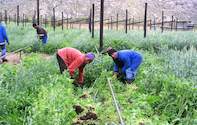Weeds are grouped into classes such as broadleaf, grasses, perennial or annual. In dryland vineyards there will be mostly winter and spring-growing weeds and in irrigated areas it is mainly grasses and reeds.

The producer should know the growth characteristics of different weeds; for example, whether it is a perennial or annual grass as weeds differ in susceptibility to herbicides. Herbicides for the use on grasses and broadleaf weeds also differ. The continued use of grass-killing herbicides can lead to an increase in broad-leaved weeds.
The time of administration is very important for the effective functioning of the herbicide as misuse can damage young vines. Constant control before the plant starts seeding can reduce weeds significantly. On the other hand, the removal of weeds can cause more soil to be exposed to the sun resulting in increased water evaporation and erosion.
With vineyards planted on slopes, sprays and fertilizers can run down and contaminate water sources. The resistance of weeds to chemical sprays is a major problem, so it is very important to switch to integrated weed control systems. Integrated weed control is a combination of various methods of weed control.
These include mechanical, physical, chemical or biological methods. The secret of integrated weed control is to combine different methods so that the weeds can not develop a resistance. Another form of physical weed control is to let the crop grow as good as possible so that there is no competition with weeds.
A different physical method of weed control is poaching or planting cover crops between permanent crops such as vines or fruit trees. To prevent seed formation of problem weeds, oats can be planted as cover crop. Hay or silage can then be made from the oats and/or weeds. It has also been found that mulching, certain cover crops and the rotation of cover crops can control the growth of weeds.
By Vinpro